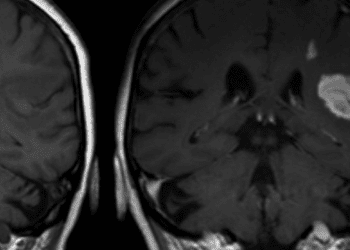2 Minute Medicine Rewind May 3, 2021
Infectivity of severe acute respiratory syndrome coronavirus 2 in children compared with adults
1. Children are most likely not the dominant drivers of COVID-19 transmissions, as their COVID test specimens were not as likely to grow in culture, had higher cycle thresholds in RT-PCR, and had lower viral concentrations, compared to adult specimens.
Evidence Rating Level: 2 (Good)
Although the pediatric population is a substantial driver of common viral transmissions, such as the flu, there is conflicting evidence surrounding the extent of their role in COVID-19 transmissions. For instance, some studies have shown higher viral loads in children, whereas others have shown similar levels in children and adults. However, no known studies have compared children and adults using other measures of transmissibility, such as a positive viral culture, cycle threshold from PCR, and the 50% tissue culture infective dose (TCID50/mL) which is the amount of virus required to kill half of the culture cells. The current study based in Manitoba, Canada collected nasopharyngeal swab tests from COVID-19 patients and their contacts, to compare these metrics between children and adults. In total, 305 specimens were cultured: 130 adult specimens, 78 from children aged 11-17, and 97 from children aged 10 and under. A positive viral culture was produced in 44% of adult samples (95% CI 35-53%), 19% of 10 and younger samples (95% CI 11-28%), and 23% of 11-17 year old samples (95% CI 14-34%). Compared to the adult samples, the p-values were 0.003 and < 0.001 respectively for the 11-17 and under 10 age groups, and no significant difference was found between the pediatric age groups (p = 0.5). 48% of children under 10 had asymptomatic infections, compared to 24% of the 11-17 group and 7% of adults. Additionally, the cycle threshold for RT-PCR was lowest in adults (18.7, IQR 17.9-30.4) compared to 22.2 in the 11-17 age group (IQR 18.3-29.0, p = 0.02) and 25.1 in the under 10 age group (IQR 17.7-31.3, p < 0.001). Lower cycle thresholds indicate higher quantities of viral genetic material in the samples. As well, the median TCID50/mL was lower in the 11-17 group (316, IQR 178-2125) compared to adults (5620, IQR 1171-17800, p < 0.001), but the results for the under 10 group and adults were not significantly different. Overall, the study demonstrated that the pediatric population is less likely to drive COVID-19 transmissions, which has implications for public health measures concerning this population, such as re-opening schools and daycares.
1. Inflammatory bowel disease (IBD) is associated with increased risk of coronary microvascular dysfunction (CMD).
2. Surgical intestinal resection in IBD patients improved coronary flow velocity reserve (CFVR), a measure of CMD.
Evidence Rating Level: 2 (Good)
Inflammatory bowel diseases (IBDs) include conditions such as Crohn Disease (CD) and Ulcerative Colitis (UC). They are characterized by acute and chronic inflammation of the gastrointestinal system, which can cause harm to the intestinal microvascular system and cardiovascular system. IBD was previously shown to be associated with reduced coronary flow velocity reserve (CFVR), a measure for coronary microvascular dysfunction (CMD). The current prospective study examined the extent of CMD in IBD patients, and the effect of surgical intestinal resection on coronary flow velocity (CFV) and CFVR. The study population consisted of 37 patients with IBD (aged 44±15), and 30 control patients (aged 46±12) with similar risk factors for coronary artery disease. The CFVR was measured with Doppler echocardiography, at rest and in hyperemia (during an infusion of ATP). For IBD patients, the CFVR was measured 1-5 days before and 3-6 months after surgical resection. The results found that 38% of IBD patients had CMD, whereas 0% of controls had CMD. At baseline, the CFVR was significantly less in IBD patients than in controls (for CD: 2.92±1.03, p < 0.05; and for UC: 2.99±0.65, p < 0.05). After surgery, coronary flow velocity was not significantly altered in IBD patients without CMD, whereas for those with CMD, the resting CFV was reduced (-19%±25%) and hyperemic CFV ameliorated (21%±34%). As well, CFVR was significantly improved in IBD patients both with and without CMD, though the extent of improvement was greater in those with CMD (interaction effect p < 0.001). The study showed that IBD is associated with greater risk of damage to the coronary arteries, and surgical resection may improve microvascular function.
1. Individuals with bipolar disorder at higher risk of chronic kidney disease after lithium initiation include patients who are young, female, obese, have high LDL cholesterol, and have lower baseline eGFR levels.
Evidence Rating Level: 2 (Good)
Lithium is the standard first-line treatment for bipolar disorder worldwide. However, due to its narrow therapeutic window and potential adverse effects, its use has waned. A rare adverse effect of lithium is irreversible kidney failure, with a prevalence of 0.23% compared to 0.11% for the general population. The current study created a model to classify individuals as high-risk or low-risk for developing chronic kidney disease (CKD) after initiation of lithium treatment. The study population consisted of patients aged 16 and over with a diagnosis of bipolar disorder for which lithium was prescribed, had a normal or close to normal kidney function at baseline, and had three estimated glomerular filtration rates (eGFRs) measured after lithium initiation. Patients were taken from two databases, 1609 from the Aurum database and 934 from the Gold database for external validation. For the Aurum cohort, 24.92% of patients developed stage 3a or greater CKD. Using eGFR trajectories to define the high-risk and low-risk group, 87.96% in the high-risk developed stage 3a or greater CKD, and 16.43% in the low-risk. 11.87% of the cohort was determined to be high-risk. The high-risk group was more likely to be younger, female, obese, have a high LDL cholesterol, and have a lower baseline eGFR. The same factors were found in the high-risk group for the Gold cohort. Overall, the study developed a model that classified around 10% of patients to be at higher risk of kidney injury after lithium initiation, which may have implications for alleviating concern around lithium use for patients identified as low-risk.
1. Older patients presenting to the dentist with missing teeth were more likely to have Alzheimer’s Disease.
Evidence Rating Level: 2 (Good)
The association between cognitive impairment and worse oral health is well-established: In particular, individuals with cognitive impairment are at greater risk for having missing teeth, cavities, plaque accumulation, and periodontal disease. As aging populations are beginning to prevail in countries like Japan, identifying early signs for dementia are becoming increasingly important. The current cross-sectional study investigated the association between the number of teeth and presence of Alzheimer’s Disease. The data was taken from a national database of dental and medical care claims in Japan, identifying patients 60 years and older diagnosed with periodontitis, missing teeth, or Alzheimer’s Disease. The study found that the prevalence of Alzheimer’s was 3.0% and 3.7% in patients with periodontitis and missing teeth respectively. In patients diagnosed with periodontitis, those with fewer teeth had higher prevalence of Alzheimer’s (p < 0.001): 1.95% of Alzheimer’s patients had 20-28 teeth present, 3.87% had 10-19 teeth, and 6.86% had 1-9 teeth. The odds ratios were 1.11 (95% CI 1.10-1.13) and 1.34 (95% CI 1.32-1.37) for patients with 10-19 teeth and 1-9 teeth respectively (p < 0.001). For patients diagnosed with missing teeth, the same association was present (p < 0.001): 2.67% of Alzheimer’s patients had 20-28 teeth present, 5.51% had 10-19 teeth, and 8.70% had 1-9 teeth. The odds ratios were 1.40 (95% CI 1.36-1.44) and 1.81 (95% CI 1.74-1.89) for patients with 14-27 missing teeth and 28 missing teeth respectively (p < 0.001). In summary, this study demonstrated that older individuals with fewer teeth are at a greater likelihood of having Alzheimer’s Disease, providing a potentially novel risk factor associated with the disease.
Bariatric surgery vs community weight management for idiopathic intracranial hypertension
1. At 12 and 24 months, bariatric surgery was superior to a community weight management program at decreasing intracranial pressure (ICP) in patients with idiopathic intracranial hypertension (IIH).
2. Patients in the bariatric surgery group had improved body weight and BMI compared to the weight management program.
Evidence Rating Level: 1 (Excellent)
Idiopathic intracranial hypertension (IIH) is characterized by heightened intracranial pressure (ICP), leading to chronic headaches, papilledema causing vision problems or loss, and overall reduced quality of life. IIH affects mostly women between the ages of 25 and 36, and weight gain is the main risk factor. A reduction in weight of between 3-15% has been correlated with IIH remission, and so interventions that prioritize weight loss may effectively treat IIH. This multicentre, randomized controlled trial compared bariatric surgery and a Weight Watchers community weight management program, to determine which would decrease ICP more, as measured by a lumbar puncture after 12 months. The study population consisted of 66 women with a BMI greater than 35, and a mean±SD age of 32.0±7.8. They were randomized evenly between the surgery and weight management groups. The mean±SD baseline opening pressure for the lumbar puncture was 35.5±7.0 cm CSF. The study found that for the surgery group, the opening pressure decreased from 34.8±5.8 to 26.4±8.7 cm CSF at 12 months, with a mean±SE difference of -8.7±1.3 cm CSF (95% CI -11.3 to -6.1 cm CSF, p < 0.001). For the weight management group, the opening pressure decreased from 34.6±5.6 to 32.0±5.2 cm CSF, with a difference of -2.5±1.4 cm CSF (95% CI -5.2 to 0.3 cm CSF, p = 0.08). The difference in ICP was more pronounced in the surgery group than the weight management group, and was not significantly different in the weight management group. From 12 to 24 months, the disparity between the groups widened, with a difference of -8.2±2.0 cm CSF (95% CI -12.2 to -4.2 cm CSF, p < 0.001). Furthermore, the bariatric surgery group had greater improvements in body weight and BMI, at both 12 and 24 months. Overall, this study demonstrated that bariatric surgery is superior to a community weight management program for the purposes of decreasing ICP in patients with IIH, by reducing body weight.
Image: PD
©2021 2 Minute Medicine, Inc. All rights reserved. No works may be reproduced without expressed written consent from 2 Minute Medicine, Inc. Inquire about licensing here. No article should be construed as medical advice and is not intended as such by the authors or by 2 Minute Medicine, Inc.







